Love and Rage in Seattle: The Day The WTO Stood Still
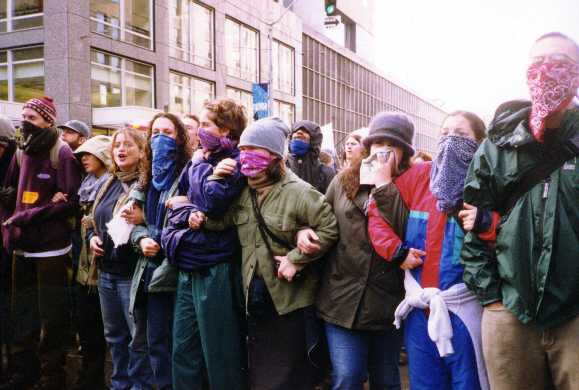
Hear this article as read by the author.
by John Tarleton
December 1999
Table of Contents
And Suddenly the Intersection Was Ours
SEATTLE—It was still pitch dark and a thin, November drizzle was in the air when the H Cluster counciled for the last time. Our scouts, just back from recon, reported that the coast was clear. Sitting in the wooden pews of an old, downtown Seattle church we reviewed our target once more. 6th and Union it would be. We were five blocks from ground zero. And, we were ready to shut down the WTO.
The World Trade Organization, one of the world’s most powerful and
unaccountable institutions, was scheduled to begin its annual summit later
in the morning. While the trade ministers, the corporate functionaries and
the international press slept in their luxury hotels, ordinary people
like ourselves were mobilizing all around the city to stop them in their
tracks.
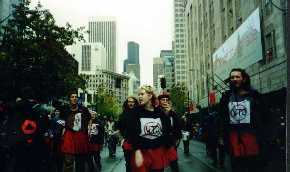
A colorful procession of 80 or so people left the church at roughly 7 a.m. We journeyed three blocks to 5th and Seneca and then turned up a block to 6th St. The Seattle Police Department (SPD) had formed a defensive line behind the intersection at 6th and Union, one of the key entry/exit points to the Washington State Convention and Trade Center. Paper mache butterflies hovered over us as we moved quietly and purposefully. We waited for the traffic lights to turn green so we could cross each street en masse. The police stayed frozen in their position. And suddenly, the intersection was ours.
Those of us who were “arrestables” locked arms and sat down on the wet pavement 15 feet in front of the police line. The intersection was soon filled with drummers and dancers. And, the monarch butterflies bobbed above the festive throng.
The Radikal Cheerleaders fired up the crowd (“Hey, hey. Hey, ho. The WTO has got to go!”...“This is what democracy looks like! This is what democracy looks like!”). Sitting with our backs to the police, we watched the spectacle in front of us. After days of nerve-wracking preparation, I was caught by surprise.
For a brief moment it was possible to believe that our singing and dancing could hold back the forces of the State.
A Constitution for the 21st Century
The World Trade Organization was founded in 1994 as the successor to GATT
(General Agreement on Trade and Tariffs), an obscure, Geneva-based
organization that had been charged since the end of World War II with
gradually reducing international tariffs. The original WTO treaty was
seven years in the making and 22,000 pages long. The WTO’s stated
mission
is to referee the global economy, to provide a “level playing
field” for
all competitors. Or, as Renato Ruggiero, the WTO’s first
Director-General,
put it: “We are writing the Constitution for the 21st Century.”
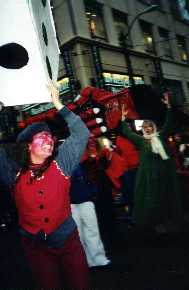
In the name of “free trade”, the WTO’s 135 member nations have given it sweeping new powers to arbitrate trade disputes. Any country, at the behest of its local corporations, can challenge another country’s laws before secret, three-person arbitration panels. Almost any national, state or local law that protects the environment, workers’ rights, consumer rights or human rights can be construed as a “trade barrier” and thus be declared “WTO-illegal”. Any country that refuses to acquiesce to a WTO ruling is subject to severe trade sanctions. Since its inception, the WTO has heard over 20 cases. And every law that has been challenged has been overturned.
The WTO’s trade ministers came to Seattle looking to launch a wide-ranging new round of trade negotiations (the “Millennium Round”) that would aggressively expand WTO supervision into such areas as financial services, electronic commerce, agriculture, forestry and intellectual property rights including the “right” to patent plant, animal, and human genes.
In the WTO world of the near future, everything would be a commodity to be bought and sold under WTO-mandated guidelines. Along the way, this secretive, self-serving organization forgot only two things: the Earth and its people.
Holding the Line
The rain stopped just after dawn and by early morning there were cracks in the thick gray clouds. Acorn, a calm, round-faced woman, was on my left. And a red-bearded man named Jesse was on my right. Like most of those in the streets, they were somewhere in their 20s.
Our line alternated between sitting (better if the police advanced) and standing up to block approaching delegates, many of whom came from the nearby Hotel Sheraton.
At one point, an older, benign-looking police officer came over and spoke to us. He told us to tell the delegates that the police didn’t want them crashing through our lines. His name was Sgt. Vander Keeven and he had a gray moustache and a big belly as soft and as round as a doughnut.
“We don’t want there to be any violence,” he said reassuringly.
Frustrated Delegates
Nonetheless, some delegates became enraged and tried to barrel through the
lines. They could not believe that ordinary people were depriving them of
their “right” to meet behind closed doors and cut backroom deals
that
affect the lives of billions of people and trillions of dollars in
commerce.
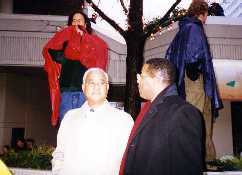
Others, including a French member of the European Parliment, reminisced about how they too were once radicals who now fought the system from the inside. We remained peaceful but firm: the WTO was being shut down for the day. They continued down the street probing for another entry point. Likewise, several credentialed journalists tried to get through the lines.
“I need to get inside to file a story,” said a German journalist. His forward progress had been stopped and he was not amused.
“What do you mean?” Someone asked. “The real story is happening out here.”
The man snorted and then stormed back to his hotel.
420 Denny
The surreal insurrection that burst onto the streets of Seattle on
November 30 was incubated in a sprawling warehouse space at 420 E. Denny
Way on a hill just outside of downtown. A large banner hanging in the
front lounge (“The WTO Sucks. And You Can Too. Wear a Condom.”)
captured
the mood of the moment: defiant yet intensely practical. The space was run
by the Direct Action Network (DAN), which was coordinating a nebulous but
well-prepared array of activist groups including Global Exchange,
Rainforest Action Network, Ruckus Society, CISPES, the IWW, the Green
Party of Seattle and Earth First! of Seattle.
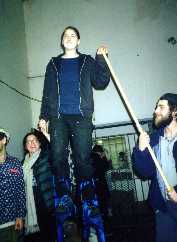
For 10 days, 420 Denny was a supercharged beehive of activity that included workshops in giant puppetmaking, dance, spoken word and radikal cheerleading, non-violent direct action training, jail solidarity training, WTO teach-ins and more. In back, there was a kitchen that cranked out thousands of free, vegetarian meals each day.
13 Pie Slices
The point of all this was to launch a mass non-violent direct action on “N30” that would shutdown the WTO. A map of downtown Seattle hung on a wall. It was divided into 13 pie slices lettered A-L, all of which converged on the convention center. Different groups of activists from all over the country banded together in clusters to claim slices of the pie. They then worked autonomously on plans for seizing the key points in their slice.
At the same time, a legal collective, a First Aid collective, an independent media collective, a tactical team and a communications team had been organized to facilitate different aspects of the N30 direct action. Decisions inside of groups and among groups were made in circles that used consensus process. It was tedious and time-consuming. There were no leaders to give orders. But when the meetings ended, people were of one mind. The Seattle Post Intelligencer would later huff about how the WTO blockaders were a “disorganized, headless, heat-seeking organism”. Nothing could be further from the truth.
Brave Enough to Be Vulnerable
The 420 Denny space was wide open to everyone including the media and
police informers. I found it on my first morning in Seattle, a week before
the big day. I had come to town with vague ideas of covering the WTO
conference and learning more about globalization. I quickly surmised that
420 Denny was the rockin’ place to be.
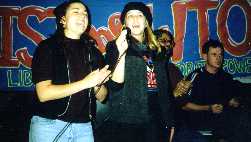
Scruffy kids in their teens and 20s were hyper-informed about the issues. And, determined to act. Their enthusiasm was infectious. I began interviewing people and taking notes. Still, I wasn’t satisfied.
I joined a direct action training session one evening and had a moment of understanding while sitting on the floor among 40 other people who, in spite of their fears, were calmly rehearsing possible arrest scenarios.
It was no longer enough to write nice words or to wish them well. I wanted to cover the protests and the protesters in an authentic manner. I believed in what they were doing and in their courage and their integrity. They were brave enough to be vulnerable. I wanted to be at their side.
The Hard Team
An hour into our street carnival, the riot police (the “Hard Team” in police lingo) showed up for the first time in their Darth Vader outfits. They were equipped with batons, tear gas canisters, pepper spray, gas masks, guns and an armored personnel carrier. Snipers with automatic rifles took their positions on the flanks of the police lines.
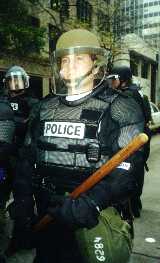 The riot police put on their gas masks. A woman in a bright red beret
hurried down our line with a bottle of vinegar solution to smear on the
inside of our bandanas.
The riot police put on their gas masks. A woman in a bright red beret
hurried down our line with a bottle of vinegar solution to smear on the
inside of our bandanas.
“Remember to keep your arms locked tight,” Jesse said. “If you let your elbows sag, it will be easier for the police to drag you away.”
I took a big gulp and concentrated on breathing slowly through my nose. I thought of Gandhi and King and in a flash I understood what civil disobedience is all about: You are putting your body and your freedom on the line for something you believe in with all your heart AND you are completely exposed to anything that could happen.
Then, just as suddenly, the riot police disappeared.
“Whose Streets?! Our Streets?!”
Th next hour or so was like a dream as the riot police appeared several times, put on their gas masks and then disappeared just as quickly. Marchers coming up from Victor Steinbroeck Park swelled our numbers. The drum circle rhythems intensified as the intersection filled with protesters, green and blue sea turtles and giant puppets. We heard via walkie-talkie that Clusters I and K had already been gassed. For us, it was only a matter of time.
The police first tried to advance on horseback. But, so many people were sitting close together (which makes horses skittish) that the cops had to pull back.
A police loudspeaker continued droning on: “This is an unlawful assembly. You have five minutes to disperse....”
The police were desperately hoping that word of an impending assault would be enough to drive most of us away. Instead, the crowd became larger and more defiant.
“Whose streets?! Our streets! Whose streets?! Our streets!” The
crowd
roared back.
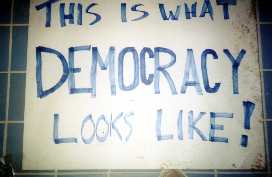
I looked over my shoulder and saw several people, including a silver-haired grandmother in a gas mask, standing directly in front of the police lines. A protester with a bullhorn encouraged the police to look elsewhere.
“Why,” he asked, “do you threaten peaceful, unarmed protesters with batons and tear gas and armored personnel carriers when the real criminals are in that building behind you?!”
The crowd resumed chanting: “Hey, hey. Ho, ho. The WTO has got to go. Hey, hey. Ho, ho. The WTO has got to go....”
Thousands of people were obstructing traffic around the convention center. At this point, the Seattle Police Department had several options. 1.) Leave things as they were, 2.) Haul away thousands of peaceful protesters who were ready, well-trained (and in some cases eager) to be arrested, or 3.) Use overwhelming force to temporarily disperse the crowd.
The riot police tapped their extra long, bourbon-colored batons for reassurance, and put on their gas masks. Video cameras were everywhere and the crowd called out in unison, “The whole world is watching! The whole world is watching!” as the police advanced.
The Police Attack
Soon, the air was filled with the insidious, burning aroma of tear gas. I
began crying and choking. The last thing I saw before pulling my bandana
over my eyes was people near me being sprayed with pepper gas.
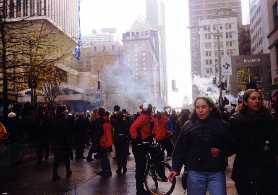
Cries of anguish were mixed with the popping sound of rubber bullets being fired into the center of the crowd. Acorn called out, "Let go!" and I released her wrist. I lay crumpled on the ground expecting to be dragged away by the police at any moment. I had one hand on my bandana and the other cupped over the back of my head.
Nothing happened. Then, I heard a friendly voice call out, “He needs help!”.
Someone calling himself Nurse Ed grabbed me under my armpits and dragged me 100 yards away from the intersection. After a few minutes, I reluctantly lowered my bandana and someone doused my eyes with cold water. I looked back at the intersction. It was covered in a white haze and an armored personnel carrier sat in the middle of 6th and Union.
The Vandals
After the police seized 6th and Union, I did interviews with Belgian and
Taiwanese television and then drifted through lower downtown trying to
discern my next move. Self-styled anarchists from Eugene,
Oregon were
now roaming in formation through the streets. They were dressed in black
and only their eyes were showing. One of them dragged a mangled newsrack
down the street while others went and surrounded innocent dumpsters and
hauled them out of back alleys.

These vandals were pathetic and only a few dozen in number. They believed in nothing more than their own rage. What can you say for people who think they are “destroying capitalism” by spraying graffiti and setting trash fires in the middle of the street?
Later, the vandals would begin sporadically smashing storefront windows at
a safe distance from police lines. This sideshow would later become the
pretext for the police violence that rained down on the 99% who were
peaceful. It turned a massive but peaceful direct action into a
media-caricatured “riot”. It was a betrayal of thousands of
other genuine
anarchists. If the vandals had not existed, the authorities
would have had to invent them.
Lockdown at 6th and University
The day’s most spectacular lockdown was at 6th and University,
another key
intersection. I arrived at 11:30 a.m. and watched the riot police tear gas
and pepper spray a small cluster of people in the intersection. The video
cameras were whirring and the crowd began singing the Star-Spangled Banner
as the Darth Vaders retreated once again.
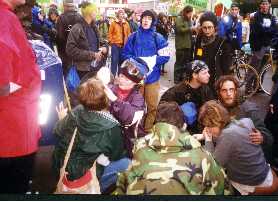
At the center of all this, I found six activists with forest names like Spike and Eeyore and Israel. Lying flat on their backs, they formed a hexagon in the middle of the street. Their arms were linked together through hollow steel tubes that were encased in rubber, tar and 18 inches of cement. Each lockdowner controlled a lever inside their lockboxes that allowed them to release if he or she chose to.
The _________ Hardcores, as they called themselves, had already been gassed four times since 8 o’clock. They had a dozen or so friends from their affinity group who ministered to their needs and who huddled over them during the police assaults. They were expecting another attack and I couldn’t turn away when they called for more help.
Spike
I knelt down in front of Spike, a 30ish woman with sandy blonde hair. I massaged her legs while someone else massaged her aching shoulders. She had been lying in the same position for over four hours.
The riot police put on their gas masks again. I smeared more vinegar on my bandana and conferred for a moment with Roots, the woman next to me. If she gave my right knee three quick squeezes, I should let go of Spike. Then, the police took off their gas masks.
During the lull, a curious television reporter approached Spike and asked how she was doing. The drummers were still raging. Solid lines of people were blocking delegates from entering the convention center. A big, blue whale named Flo was beached in the middle of the street. The WTO’s opening session had been delayed until 2:30 p.m. and would later be cancelled. Gilded downtown Seattle was, for a day, a giant shopping-free zone.
“I feel one with everyone right now,” Spike said. She was both exhausted and euphoric. “This is great!”
The riot police prepared several more times as if to attack. But, they did not advance. Spike began to talk about the conversations she had the night before while sipping drinks with Third World delegates at the bar of the Hotel Sheraton.
“A lot of them are pissed,” she said. “A lot of the benefits they were promised when they joined the WTO haven’t happened. We should talk to them as people. And the same too with the police. Every nice thing you say to a cop, there’s one less chance I’ll get my head cracked open by a baton.”
The police, according to later reports, had temporarily run out of tear gas. The Hardcores held a council right where they lay and discussed their options. A couple of them liked the idea of keeping the fiesta going all night. Others favored clearing out at day’s end. The latter view was eventually consensed to.
“An important thing I’ve learned,” one of the Hardcores said, “is to know when to declare victory and leave.”
Two Different Languages
Before I left 6th and University, I stopped and listened to a conversation that a US trade official was having with youthful protesters. He was calm and empathetic. His blow-dried, blond hair was perfectly in place. He reminisced about how he once marched against the Vietnam War.
“I feel your pain,” he started to say before he was cut short by laughter.
He was peppered with questions about a variety of US trade policies and related WTO rulings. The protesters wanted to know where he stood on these issues. He was noncommittal.
“I’m in the listen mode right now,” he said. “What I believe doesn’t matter.”
His questioners were astonished. “How can you say what you believe in isn’t important?” Someone asked.
It was as if two different langauges were being spoken. I drifted on
around the convention center. Lockdowners were still holding strong at
Seneca and Hubbell and Seneca and 8th. The Paramount Theatre, where the
opening ceremonies were originally scheduled to occur, was surrounded by a
large number of protesters.
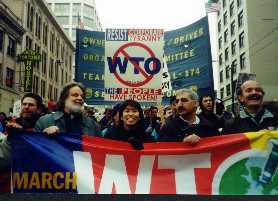
The big AFL-CIO labor march was passing nearby. Some unionists broke ranks
to join the direct action. But, most continued back to the stadium where
they started. Big Labor, as usual, was setting narrow parameters on its
own dissent.
The SPD's Last Stand
As dusk settled over the city, more trouble started. A bunch of local kids, inspired by the nonstop TV coverage, smashed their way into Niketown at 6th and Pine and stole a bunch of sneakers. Meanwhile, Mayor Paul Schell had declared a state of emergency and two units of the National Guard were being sent in as re-enforcements. The mayor also authorized the use of a more potent form of tear gas.
Releasing a day’s worth of pent-up rage, the rearmed SPD began firing off large quantities of tear gas and concussion grenades. On TV, downtown’s concrete corridors looked like a besieged war zone. In reality, most protesters had already gone home for the day.
By nightfall, the SPD had blasted the last protesters out of downtown and across I-5. At that point, the small band of protesters could have gone home for the day. And the police could have just as easily returned to their primary mission of securing downtown.
Instead, the two rioting groups continued their antics long enough to appear live on the 10 o’clock news. The protesters overturned dumpsters in the middle of Pine St. And, the police slowly pushed them back toward Broadway, indiscriminately lobbing tear gas canisters into crowds of curious onlookers, including parents and their children. An evil white haze hung over the neighborhood.
“We’re not protesters by nature. We have jobs,” said Jeanette Wallis, a psychiatric counselor who lives in Capitol Hill. “We were in our homes at 9 o’clock and there were bombs going off in our neighborhood. And we stepped outside to see what was going on.”
Kevin Harris, a web page designer who also lives in Capitol Hill, was standing in the street with Saj, his 8 year-old son, when they were accidentally gassed by the police. Saj, who is a second grader at Madrona Elementary School, began choking so badly that he thought he was going to die. Several days later he was still suffering headaches.
“I am angry about this,” Harris said, “in a way that words cannot even begin to describe.”
Final Thoughts
Thousands of young people braved tear gas, batons, and rubber bullets on
November 30 in order to shut down the WTO. Tom Hayden called Seattle
’99
more important than Chicago ’68. Newsweek speculated that it
marked
the beginning of the globalization of social activism. So, how were the
youthful rebels able to pull off this massive, mostly peaceful direct
action?
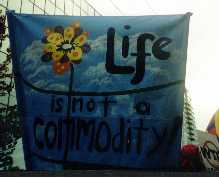
Organizers weren’t the least bit secretive about their stated goal of shutting down the WTO. SPD squad cars periodically circled DAN headquarters at 420 E. Denny. And, according to published reports, various law enforcement agencies, including the FBI, had infiltrated radical protest groups since early in the summer.
Some Third World delegates were convinced that the protests were sponsored by the Clinton-Gore administration in order to gussy up to environmentalists and labor unions. Other conspiracy-minded folks believe the government let the direct action happen because it knew that groups like the ones from Eugene would screw everything up and discredit the whole anti-WTO movement in the process.
Beyond Apathy
A simpler answer is this. We have been a nation of sheep for so long that our leaders thought we were too apathetic to care about anything, least of all the WTO. When they saw announcements about shutting down the WTO, they must have laughed and imagined some pathetic, half-assed protest against The Ruling Class. Perhaps, they thought we couldn’t do any better than that.
If so, they guessed wrong.
LINKS:
LA Kauffman, Free Radical: How We Made It from the '60s to Seattle
Quebec City: April 20, 2001
Independent Media
Center
Ruckus Society
Direct Action Network
People's Global Action
Network
Official WTO Web Site
WTO Watch
Public Citizen
International Forum on
Globalization
Photos by John Tarleton and Stephanie Greenwood.
Back to On the Road with John Tarleton